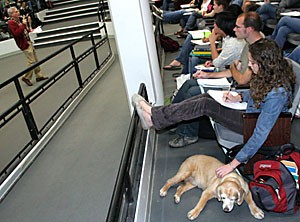In a world that focuses on name-brand backpacks, cutting-edge cell phones and jewel-adorned purses, many UA students are toting around a more unusual accessory – their pets.
“”It’s kind of like walking around with your best friend all the time,”” said Hollie Constant, an anthropology senior, referring to her miniature Chihuahua, her constant companion on campus.
Constant’s 4-pound dog, Papi Chulo, rides along with her to class in a bag about the size of a purse.
“”Sometimes, people don’t even realize that I have him,”” Constant said. “”Then mid-lecture they’ll notice him and say, ‘Oh, you have a little dog on your lap,’ and then continue the lecture.””
Papi Chulo has attended many of Constant’s classes, including Indian Archaeology, Sociology of Latin America and Japanese Pop Culture. He also goes with her to the grocery store, the movies and restaurants, Constant said.
Papi Chulo rarely barks, and Constant only remembers one time when he made noise in class because “”he wanted his toy.”” She also carries toys, treats and a water bottle for Papi Chulo to drink out of.
Constant doesn’t mind the attention her dog attracts and said generally women think he is cute, while men give her a funny look.
“”Whatever, the dog makes me happy. If you think they’re stupid then don’t get one,”” Constant said.
She said none of her professors mind the dog attending class – with the exception of David Soren, a regents’ professor of classics who also brings his dog to class. Two dogs in one class might cause a commotion.
Soren said he has been taking his dog Angel places with him for nine years due to a medical condition.
He used to suffer from high blood pressure and hypertension, and a stress psychologist suggested he bring a dog with him all day.
“”Almost immediately after beginning this, my blood pressure went down and my hypertension went away from being forced to slow down, pet and walk the animal and generally discuss my problems with her,”” Soren said.
Angel does not cause much of a distraction during class, Soren said, adding that students actually like to pet her when they write their exams.
Though students may spot dogs being carried around to classes, one student prefers to bring her prize rabbit as a companion in a green and pink “”Juicy”” carrier.
“”He’s all white with blue eyes, and that’s really rare in rabbits,”” said Renita Ho, a senior majoring in molecular and cellular biology and anthropology. “”I bring him around mainly for company.””
Her Mini Rex rabbit, Skip, has been to her Spanish class and her anthropology senior capstone class. He is potty-trained so he waits until Ho takes him out for a hop before he does his business.
Ho bought her rabbit at a bunny show in Casa Grande about nine months ago and has been toting him around since then, she said.
She said she has a special attachment to the animal because she was not allowed to have a pet when she was growing up.
The University Handbook for Appointed Personnel states that animals are only allowed if they are service animals that help people with disabilities, or if there is prior permission from the department head and only for official purposes.
There are similar rules for students in individual department handbooks, but no one seems to mind the extra attendees in class, according to the Office of the Dean.
“”Most people don’t recognize that I have a rabbit in my bag,”” Ho said. “”Even my teachers think he’s really cute and they like to pet him.””









